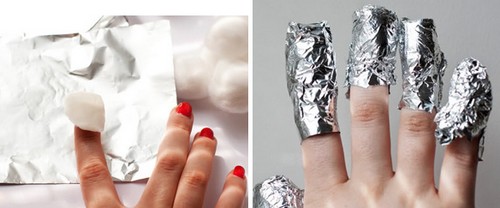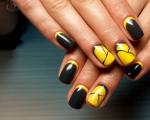How to remove shellac at home without damaging the nail plate?
Modern women make every effort to remain not just beautiful, but flawless. Beautiful hands and manicure are one of the factors demonstrating the success of a lady and her status in society.
But the modern rhythm is merciless to a woman; she must take care of herself; responsibilities such as laundry, cooking and washing dishes are entrusted to her fragile shoulders. A simple manicure is simply not able to withstand such tests and quickly loses its beauty and integrity. No matter what measures are taken, the varnish will still crack, begin to fall off in pieces and take on a simply ugly appearance.
That is why modern developments in the beauty industry in the field of nail care have become a real find for women. Among the variety of services that a manicurist can offer his clients, gel polish or shellac coating is the most popular.
What is shellac?

Shellac is a nail polish created based on gel technology. If we consider its external qualities, then there are practically no differences from simple colored varnishes. But if you look deeper, the differences become obvious: shellac does not dry in the open air; an ultraviolet lamp is needed to polymerize it.
This product has become a real find for those with thin, brittle and flaking nails. This coating has a strengthening effect on the natural plate, prevents delamination and protects from external influences.
If we continue to compare shellac with varnish, it should be noted that such a coating lasts on the nails for about 30 days or even more. Moreover, the gel polish does not chip, does not crumble, does not have a negative effect on the nails and does not require a break to rest the plate.
Advice: “Shellac can be used for manicures and pedicures, and a wide palette of colors can satisfy the desires of even the most capricious client.”
Shellac coating is durable, but there are different situations in life and you may need to change the color of your manicure completely suddenly, so the question arises: how to remove shellac at home?
How can you remove shellac at home?
Of course, the salon will offer a removal procedure using a specialized product designed for this. But if you don’t find such a product at home, you can use a more budget-friendly product. Such a product could be nail polish remover containing acetone.
If you use a product without acetone, the coating will perhaps lose its glossy shine, but it will not be possible to remove it completely.
Advice: “Do not cut down the coating using saws. This will lead to the cutting of the natural nail plate, damage to the cuticle, and possibly the spread of infection.”
Removing the coating with a specialized product

It is quite possible to remove shellac at home if you first prepare for this process. Before you start removing the bright coating, you need to purchase the tools and materials you will need:
- A specialized material softening agent – remover;
- Plain kitchen foil;
- Cotton pads for removing makeup or cotton wool;
- Fine-grained file for natural nails or buff;
- Orange sticks;
- Cuticle softening oil.
Advice: “Before you start applying the special product, you must wash your hands thoroughly. Additionally, you can also disinfect them, for example, with formic alcohol.”
Instructions for removing such coating consist of the following steps:
- Preparation of consumables. The foil should be cut so that one piece can be wrapped around the upper phalanx of the finger. If you use cotton pads, it will be more convenient to use pieces of ¼ disc size.
- Cotton wool or pieces of a cotton pad are generously lubricated with remover and applied tightly to the nail itself. It is important that the product used comes into minimal contact with the skin.
- The nail plate along with cotton wool must be wrapped in previously cut pieces of foil and fixed on the finger. This procedure must be repeated for each coated finger.
- Next, the nail wrapped in foil should be left for 10-15 minutes, during which time you can try to rub the coating with cotton wool in the foil, but you should not overdo it in this process.
- The foil and cotton wool with remover are removed from each finger one by one.
- The softened gel polish is removed from the surface of the nail using an orange stick.
- After removing the gel polish, you should treat the cuticle with oil, rubbing it in with smooth movements.
- If after processing there are pieces of coating left that cannot be removed, the procedure should be repeated again.
Removing gel polish with acetone

At home, the remover can be replaced with acetone, and the removal process itself in this case will be completely identical. When using pure acetone, you should be careful, because this substance dries out the skin around the nails and can cause allergies and irritation.
After this procedure, the skin around the nails must be moisturized and restored.
Removing coating without acetone
If there is no acetone-containing nail polish remover or even pure acetone in the house, then this solvent can be replaced with isopropyl alcohol, which is easy to buy at any hardware store. This product has a strong aroma and, like acetone, can cause irritation and allergies. Keep this alcohol in foil with your finger for no more than 15 minutes.




